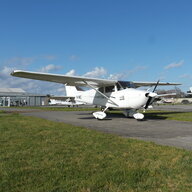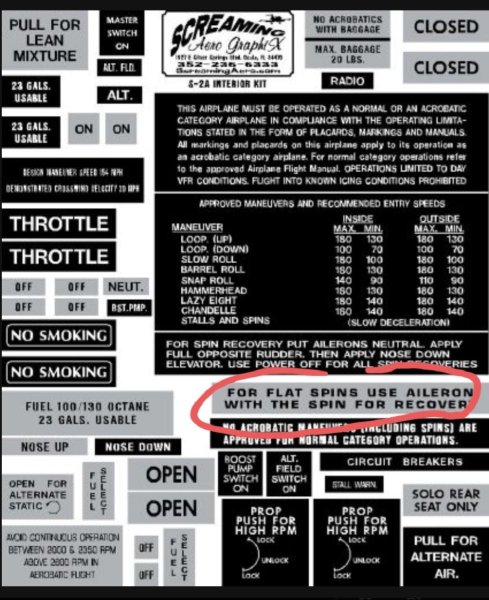-
Posts
401 -
Joined
-
Last visited
-
Days Won
1
Content Type
Profiles
Forums
Gallery
Downloads
Blogs
Events
Store
Aircraft
Resources
Tutorials
Articles
Classifieds
Movies
Books
Community Map
Quizzes
Videos Directory
Posts posted by Bosi72
-
-
May I ask what is the case scenario for having an axe in an aeroplane?
-
 1
1
-
-
On 26/09/2022 at 10:23 AM, RossK said:
Something I noticed on the weekend when using the Skyecho with a samsung tablet with cellular.
With the SE connected, I lose mobile data, and avplan traffic as a result, also lose weather info, ability to download terminal info etc.
If I disconnect the SE, then mobile data is restored.
What am I doing wrong, or is this an AVplan Android version bug?
Try "Mobile data only apps" Android option. Then scroll down to Avplan and turn it on.
Hope this helps
-
 2
2
-
-
TBH I don't know, but if these are the bolts you're after, I would be asking if they have them (Part# 05-06757
MFR Model# 01-60-001)https://www.aircraftspruce.com/catalog/appages/duc_swirlwindspn-hardware.php?clickkey=212019
-
 1
1
-
-
Did you try
They are in YMMB, but you need to know exact part number that you'd normally look on aircraftspruce.
-
 1
1
-
-
-
54 minutes ago, turboplanner said:
What about the MET training by your Instructor/CFI?
For sure the instructors role is very important, however not many things can be said/done in ~25 hours until your first licence.
Therefore use all possible resources to learn and improve yourself.
-
 1
1
-
-
5 hours ago, APenNameAndThatA said:
Which one did you read?
I used both Bob Tait's and BOM manual of aviation meteorology, however some people prefer other author's writing style.
Any will do the job.. and don't stop there..
There are good reading material on New Zealand CAA website
https://www.aviation.govt.nz/assets/publications/gaps/caa-gap-mountain-flying-may-2021-web.pdf
-
 1
1
-
-
24 minutes ago, Kununurra said:
So Bosi72,
did he sell?
His thought process was he wanted a Cruiser, already waited for a year, so decided to keep it..
If that was me, I'd be buying a 2nd hand ute, plus an aeroplane 🙂
-
 1
1
-
-
I have seen MTW on GAF recently, but not sure if that was on that day.
-
 1
1
-
-
On 31/08/2022 at 8:01 AM, Mat Farrell said:
All good thoughts folks, thank you.
Bosi72, yup, that's my big constraint. I thought the only way i could fly into CTA, fundamentally is to have a CASA license (RPL or PPL. working on that...) I know there are a few odd exceptions (such as approved school ops), but am I missing a trick here? As i understand it my AC is good for it (24 reg, VHF and transponder), but i'm the limiting factor.
Hi Matt
I feel devastated at this moment after reading the news and connecting the dots, especially for not encouraging you more to study and learn as much as you can.
After getting a PPL, I still felt a big gap in my aviation knowledge, therefore I've decided to read, and my first book was CPL Meteorology. Because this was the area which I wanted to learn more about, and to know what to expect/avoid when flying for fun.
As we all know, passing an exam, or getting a licence is only a "licence to learn", because we are living in ever changing environment. Therefore learning never stops.
I hope this post will encourage fellow pilots to learn more.
Rest in peace my aviation friend 😞
-
 3
3
-
 1
1
-
 3
3
-
-
I've heard a story about a guy who bought a brand new LandCruiser around $70k just before Covid (yes that was the base model price back then) with clause to wait 12 months for the car to arrive.
The guy patiently waited, then a year later, a dealer rang him and told the car arrived, however immediately offered $100k buyback for the same car.
The guy wasn't very interested in selling, however he posted an ad on some online sites with "make an offer" option.
He got flooded with offers and the highest was around $140k.
Some people change cars/bikes/boats/planes like socks..
-
 2
2
-
-
It is not that hard to learn MET acronyms, only patience and some practice is needed. The more you check the weather, the more you know..
To understand GAF, check this video
To decode TAF, you can tap in your EFB and it will decode for you (the screenshot below is from AvPlan)
Finally, if you come across the "tricky" TAF/GAF feel free to post it, I am sure everyone would help.
-
 2
2
-
 1
1
-
-
8 minutes ago, turboplanner said:
Given the weight difference and the need to fit a radiator and cooling system to the Mitsubishi, I wonder why people would be looking at diesel?
$$$
-
Not sure if this should be in Learning section of the forum. Regardless, great outcome. ~350hrs instrument rated pilot/instructor telling his story.
-
 1
1
-
-
I've just paid $16.50 to Avdata for landing at Bacchus Marsh.
Melton is free when you buy a burger (very good one) 🙂
Tyabb/Coldstram/Lilydale have donation boxes.
Whatever you decide, the weather at Kilmore or Glenburn Gap would play the key role. Maybe flying to Mangalore as an alternate, then catching the train to CBD would cut off some time. Vline doesn't stop at every station like Metro line and runs faster.
Probably the long term solution is to get Controlled airspace endorsement (assuming that's constraint) then fly to Essendon or Moorabbin (both at $35) and be as closest to CBD as you can be..
-
 1
1
-
 1
1
-
-
Why is "join upwind" so hard?
-
 1
1
-
-
5 hours ago, Mike Gearon said:
Not sure if AvPlan has similar.
Yes, in AvPlan PRO you can choose approach plates overlying ERC charts and have all features that you'd normally use when VFR (screenshot attached).
I believe there is a theory exam in the US similar to IREX or PIFR in Oz, where you learn theory, which I suggest to study and pass. Not sure about the CASA conversion process.
Also good thing is you can practice procedures from your home using x-plane or some other simulators, save $$ coming prepared for lessons.
Enjoy flying
Cheers
-
 1
1
-
-
On 30/07/2022 at 8:42 AM, Thruster88 said:
pilot had been monitoring the LED fuel lights for the last hour of flight as they were dropping into the red then back to one green bar continuously. They find them notoriously unreliable
Obviously the LED's were reliable.
According to my calculations, the pilot was ~50nm off the track from the nearest airstrip with fuel arrangements when the LED started flashing. Plus few airstrips without fuel along the track.
-
 1
1
-
-
1 hour ago, Mike Gearon said:
Does all the reg stuff look like this?
I’ve read that 3 times and it doesn’t make any more sense so no point in 4 goes. I suspect it actually says Experimental aircraft can’t have these rules applied to them and can’t fly IFR.
To my understanding the rule says if experimental or UL aircraft is certified e.g. in the US as IFR, then it can be registered in Australia as IFR too.
However, you'll get the most accurate answer by contacting CASA directly.
-
 1
1
-
-
Part 91. 26.08 Aeroplane IFR flight
https://www.legislation.gov.au/Details/F2020L01514/Html/Text#_Toc57289514
To get instrument rating, you need to:
hold at least a private pilot licence (PPL)
study the aeronautical knowledge syllabus
pass the instrument rating exam. (info from CASA website)
-
Can someone explain why the fuel price wasn't above $2 (or avgas above $3) in 2008 or 2013/14 when the barrel of crude oil was at the same price as it is today ?
-
There's probably a reason why many photos of glass cockpit have an ipad in them..
-
 1
1
-
-
Try AvPlan
-
 1
1
-
-
Maybe installing a large top cowling door would be a simple solution? Then open it every time after landing.
From memory to check oil on Foxbat I had to remove whole top cover, then finicky process to put it back
Installing a door would help with oil checks, and also cool engine bay much faster.
Installing a couple of temperature sensors would help too.
Only suggesting ideas.
-
 1
1
-







Airplane axe: a disproportionate response
in Student Pilot & Further Learning
Posted
Thanks, I believe we don't discuss airliners here.
For emergencies, tree leaves will make more smoke than big logs.
Adding little mogas/avgas will make instant bright light at night time.
Whilst axes, chainsaws are great tools, in emergencies a vhf/uhf, plb, torch, mobile phone would be more useful.
For camping purposes, I've seen battery chainsaws doing a great job for a small bonfire.
Permitting w&b, I would bring both my axe and Mini Boss, and leave Magnum at home
🙂
I can't justify buying a titanium or some space material axe (if such exists)
Cheers